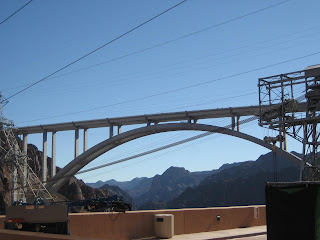What a wonderful way to spend the day. Today was clear and warm. A perfect day to take a trip through the Lake Mead National Recreational Area and Hoover Dam. We have been to the dam many times over the years but never really taken a trip inside the structure itself. So today we decided to do just that. Our docent was well versed in the construction of the dam and we found it interesting to learn about the men who built it. Construction began on the dam in 1931 and was finished two years ahead of schedule in 1935. The men worked 3 eight hour shifts around the clock, with only 2 days off per year, Christmas and July 4th. They were paid about 50 cents an hour for this back breaking and dangerous work. It was just amazing to really see what went into it's construction using the tools and equipment available to them some 80 years ago! It is difficult to imagine what it took to piece together such a masterpiece. The dam itself is totally self sufficient, supporting itself through the sale of it's electrical output. Today, my hats off to those brave souls who made such a miracle happen.
Let me begin by saying the tour inside the dam costs $11/person and is well worth the money and time. Some specifics about the dam.
Height: 726.4 ft.
Length: 1244 ft.
Width : Top 45 ft.
Bottom 660 ft.
Cost: $48,890,950 (1931 dollars)
Hoover Dam impounds the Colorado River and created Lake Mead, which is the largest man made reservoir in the United States encompassing some 247 sq.mi. surface area and 550 miles of shoreline.
This is the entrance road just prior to crossing the dam itself. The road over the crest of the dam was US93. After the events of 9/11 concern over damage to the dam necessitated construction of a new highway to restrict traffic crossing the dam.

In November 2010 a new US93 connection between Arizona and Nevada was opened. Here is a picture of the Bridge after completion. Tours are allowed and you may cross this bridge on foot using pathways along it's length. Because of high winds in the canyons large concrete walls line the roadway portions so visibility is limited in cars. RVs and Trucks must use the inside lanes when crossing this bridge. It sits 840 ft above the Colorado River.
A new visitor's center was constructed in 1995. The structure on the right is a large parking garage and houses a cafe and a gift shop. Access is only allowed from the Nevada side as the Arizona side was closed and through traffic is no longer allowed on the dam itself. Vehicle traffic may cross the dam to reach several parking facilities on the Arizona side but the visitor's center is located in Nevada.
This was taken from the top of the dam, looking down toward the Colorado River. If you look closely you can see several vehicles alongside the structure facing the dam. Those are trucks.

As part of the tour inside the dam, you're taken by elevator 587 ft. down into the dam itself. After exiting the elevator we proceeded down this corridor to where Jet Flow gates are installed. These huge pipes are in place to divert the river water around the dam in an emergency or flooding conditions.
Here is a picture of one of these huge pipes. Unfortunately, I have no objects that I could use for comparison purposes but you could easily drive two semi's side by side inside these pipes.
After leaving the Jet Flow gate room, we proceeded down to another corridor that leads to the generator room itself. All of these corridors were constructed through solid rock by using picks and dynamite 80 yrs ago.
Here's the heartbeat of the Dam Project. These large turbines are fed by river water coming through the intake pipes in excess of 85 miles per hour. There are 9 on the Arizona side and 8 on the Nevada side. Altogether, they can produce 10,348,020,500 kilowatts of electricity per year.

Here's a view of the mighty Colorado after it was tamed a bit by Hoover Dam. This is a downstream view after the water has been run through the turbines and expelled to continue it's travels to Mexico. While Hoover Dam is one of the largest hydro-electric plants in the world, we also gain other benefits with it's construction.
Through the construction of this dam, water from the Colorado is now controlled and supplies water for irrigation and municipal uses.
Water releases from Hoover Dam eventually reaches the All American Canal and is used to irrigate over 1,000,000,000 acres of farmland, as well as providing water for over 8 million people in Nevada, Arizona and California.
Next up, we will continue our journey through the Lake Mead National Recreational Area.










No comments:
Post a Comment